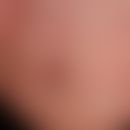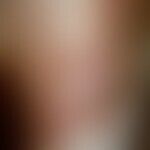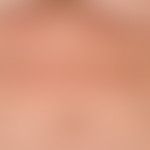Synonym(s)
HistoryThis section has been translated automatically.
DefinitionThis section has been translated automatically.
Rare, genetically determined, chronic progressive or chronic relapsing, diffuse or localized, also segmental or as cutaneous mosaic in Blaschko lines occurring skin and mucous membrane disease with acantholytically disturbed keratinization. The skin changes occur especially in seborrheic areas. Nail deformities are frequently observed.
You might also be interested in
Occurrence/EpidemiologyThis section has been translated automatically.
Family clusters. Prevalence (Denmark): 1/50 000-100 000 inhabitants; 1/36 000 (England). Incidence: 4/1 million inhabitants/10 years. The expression of the disease varies greatly among Darier families.
EtiopathogenesisThis section has been translated automatically.
Autosomal-dominantly inherited mutations of the ATP2A2 gene located on chromosome 12q23-24. The ATP2A2 gene encodes the calcium-pumping ATPase (also known as SERCA2 = sarco(endo)plasmic reticulum Ca2+-ATPase 2) in the sarco and endoplasmic reticulum. Mutations of the gene lead to defective enzyme formation and secondarily to inadequate replenishment of the calcium stores of the endoplasmic reticulum. This results in the expression of altered calcium-dependent adhesion molecules (desmosomal cadherins). These proteins are necessary for adhesion processes of epithelial cells. Their impaired biological function leads to loss of adhesion, acantholysis and apoptosis of keratinocytes.
ManifestationThis section has been translated automatically.
Mostly in children, more often peripubertal. In about 70% of patients, the disease begins between the ages of 6 and 20 with a peak of the disease during puberty. It typically progresses in relapses with phases of extensive lack of symptoms. Complete remissions are rare.
LocalizationThis section has been translated automatically.
Mainly seborrheic areas of the face and trunk, hairy head, anogenital region, palmae, plantae and nails. Mucosal lesions (primarily on the hard palate) are found in about 15% of patents. Occasionally occurring more intensely in exposed areas!
Rarely arranged along the Blaschko lines (in Anglo-American literature called "segmental Darier`s disease"). Here the genetic connection with the common diffuse phenotype has been proven.
ClinicThis section has been translated automatically.
- Initially glass pinhead-sized, isolated, reddish to brownish, mostly non-follicular papules (incorrect naming). Brown, firmly adherent keratoses confluent to form beet-like, verrucous or macerated areas. The affected areas have a dirty-brownish aspect; usually unpleasant body odor. Patients appear unkempt. Occasionally severe itching. The skin changes can often be provoked by light (occurrence in the area of the solar skin zones). Also triggered by heat and sweating.
- Characteristic roundish or bizarrely configured interruptions of the papillary lines on the palms of the hands and soles of the feet (" pits"). These sometimes expand into pits with hyperkeratosis. In addition, isolated or aggregated 3-5 mm large, yellow-brownish horny papules are found on the palms of the hands and/or soles of the feet. Extensive keratoderma is rarer here.
- Typical papules on the buccal mucosa, palate, esophageal mucosa, rectal and genital mucosa. Small-spotted leukoderma, often attached to the follicular orifice.
- The nails of the hands and feet show grooved dystrophies, also longitudinal erythronychiae with sawtooth-like edges, splinter hemorrhages, subungual hyperkeratosis, disal onycholysis.
- Also cystic bone changes, possibly schizoid traits.
- Special clinical forms:
- Vesicular-bullous variants: especially with fever and heavy sweating; enlargement of the suprabasal clefts to intraepithelial blisters.
- Intertriginous acantholytic dyskeratosis: acquired, intertriginously localized (groin, submammary, genital) papular skin changes with histological features of dyskeratosis follicularis.
- Unilateral, zosteriform Darier: Striate papules arranged in the Blaschko lines with the clinical and histologic aspect of Darier's disease (see below mosaic, cutaneous).
- Actinic comedones: Comedone formation in actinically exposed skin showing signs of focal acantholytic dyskeratosis. In very rare cases, this "comedone variant" can occur as a monosymptomatic form of Darier's disease (v. Köckritz A 2018).
- Acral verruciform papules: Disseminated, flat papules on the back of the hands and feet. Histologically signs of acantholytic dyskeratosis.
HistologyThis section has been translated automatically.
Moderate to marked acanthosis, with hyperkeratosis and focal, mostly columnar parakeratosis. Mostly clearly protruding suprabasal cleft formation. Dyskeratotic elements in the stratum spinosum and granulosum. These rounded keratinocytes isolated from the cellular structure are referred to as "corps rond". Above this, development of a columnar parakeratosis zone with individual dyskeratotic cells (grains).
Electron microscopy: Absence or greatly reduced number of desmosomes, disturbances of the desmosome-keratin fiber attachment to the desmosomes as well as perinuclear aggregates of intermediate filaments (keratin).
DiagnosisThis section has been translated automatically.
Differential diagnosisThis section has been translated automatically.
Complication(s)(associated diseasesThis section has been translated automatically.
General therapyThis section has been translated automatically.
External therapyThis section has been translated automatically.
- In mild cases external treatment with keratolytic topicals such as 0.05-0.1% Vit A acid cream/gel (e.g. Isotrex cream or gel; Cordes VAS cream, R256 ), 3-5% salicylic acid-containing topicals (e.g.Salicylvaseline Lichtenstein, Squamasol Gel) and caring hydrating preparations with 2-10% urea (e.g. Excipial U Lipo-Lotio, Eucerin 5% Urea Cream, R104 R102 ).
- In case of beginning superinfection body care with disinfecting soaps (e.g. Betaisodona washing solutions), baths with potassium permanganate (light pink). By means of a defined therapy (< 7 cm2) with 5-fluorouracil (e.g. Efudix, every 2 days for 1-2 weeks) a remission lasting for weeks to months can be achieved in exposed areas.
- In severe cases external therapy is usually of little help, external retinoids can sometimes cause unpleasant skin irritation in such cases.
Internal therapyThis section has been translated automatically.
In severe cases, systemic administration of acitretin (Neotigason) initially 10-20 mg/day p.o. until significant improvement, maintenance dose: < 5 mg/day depending on clinical outcome. With discontinuation of acitretin, the skin symptoms flare up again.
Alternative: In individual cases the success of alitretinoin in usual dosage (30mg/day p.o).has been reported.
Short-term administration of systemic glucocorticoids such as prednisolone (e.g. Decortin H) 100-150 mg/day and subsequent rapid dose reduction only in cases with a highly inflammatory, eczematous component.
In case of superinfection, antibiosis according to antibiogram.
Operative therapieThis section has been translated automatically.
Note(s)This section has been translated automatically.
LiteratureThis section has been translated automatically.
- Barfield RL et al (2002) Pruritic linear papules on a 75-year-old woman: a case of localized Darier-White disease. Cutis 70: 225-228
- Barnstedt SE (2012) Successful therapy of Darier's disease with alitretinoin. Dermatologist 63:139-141
- Burge SM et al (1995) Topical isotretinoin in Darier's disease. Br J Dermatol 133: 924-928
- Darier FJ (1889) De la psorospermose folliculaire végétante. Étude anatomo-pathologique d'une affection cutanée non décrite ou comprise dans le groupe des acnés sebacées, cornées, hypertrophiantes, des kératoses (ichtyoses) folliculaires. Ann Dermatol Syphil (Paris) 10: 597-612
- Dhitavat J et al (2004) Calium pumps and keratinocytes: lessons from Darier`s disease and Hailey-Hailey disease. Br J Dermatol 150: 821-828
- Goh BK et al (2005) Darier's disease in Singapore. Br J Dermatol 152: 284-288
- Itin PH et al (2000) Segmental manifestation of Darier disease. What is the genetic background in type 1 and type 2 mosaic phenotypes? Dermatology 200: 254-257
- Jorg B et al (2000) A hemorrhagic acral form of dyskeratosis follicularis Darier. dermatologist 51: 857-861
- Knulst AC et al (1995) Topical 5-fluorouracil in the treatment of Darier's disease. Br J Dermatol 133: 463-466
- Köckritz v. A (2018) Treatment resistant comedones (comedone variant of Darier's disease): J Dtsch Derrmatol 16: 493-495
- Oster-Schmidt C, Stucker M, Altmeyer P (2000) Follicular dyskeratosis: successful treatment with local retinoid. dermatologist 51: 196-199
- Wada T et al (2003) A Japanese case of segmental Darier`s disease caused by mosaicism for the ATPA2 mutation. Br J Dermatol 149: 185-188
- White JC (1889) A case of keratosis (ichtyosis) follicularis. Journal of Cutaneous and Genitourinary Diseases (Chicago) 7: 201-209
Incoming links (47)
Abt-letterer-siwe disease; Acantholysis; Acanthomas, disseminated epidermolytic; Acitretin; Acrokeratosis verruciformis; Alitretinoin; Apoptosis; ATP2A2 Gene; Bowen, john templeton; Cadherine; ... Show allOutgoing links (32)
Acantholysis; Acanthoma acantholytic dyskeratotic; Acanthosis nigricans (overview); Actinic keratosis; Adhesion molecules; Alitretinoin; ATP2A2 Gene; Blaschko lines; Dermabrasion; Dyskeratosis follicularis; ... Show allDisclaimer
Please ask your physician for a reliable diagnosis. This website is only meant as a reference.









































